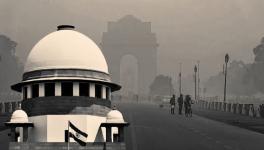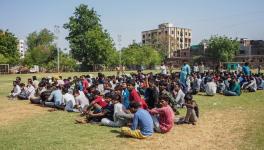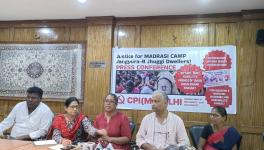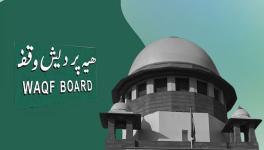Delhi Villagers Await Title Deeds 3 Years After SVAMITVA Scheme
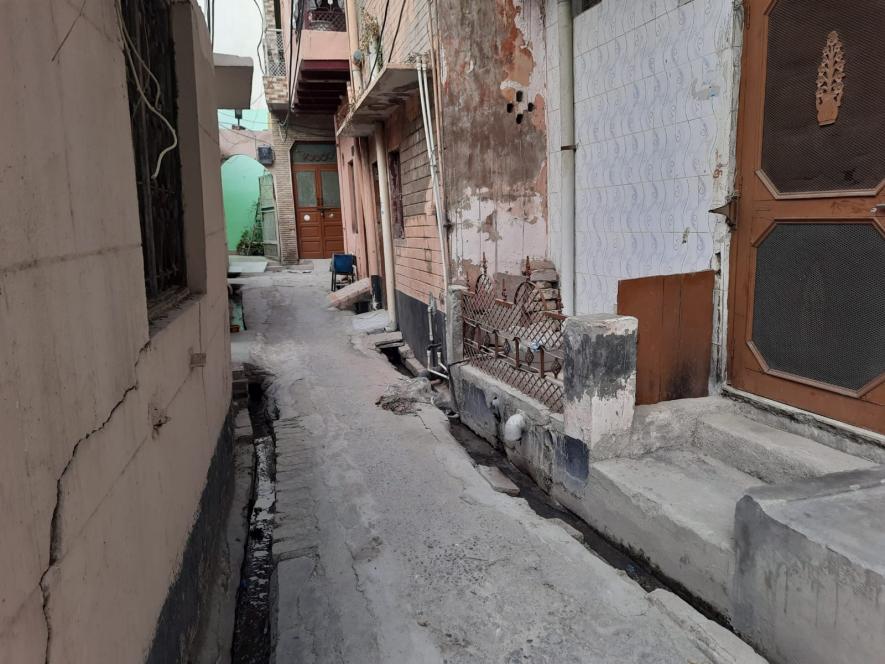
Open drains in the village Nangal Thakran show that the area lacks basic amenities provided by govt
New Delhi: Pradeep Dagar feels that “most people and the government believe that there are no farmers in Delhi”. He is a native of Dhansa village, south Delhi. In Delhi’s northwest corner lies Nangal Thakuran village. Residents of these villages are among the thousands of farmers in Delhi solely dependent on agriculture.
On Panchayati Raj Day on April 24, 2020, the SVAMITVA (Survey of Villages Abadi and Mapping with Improvised Technology in Village Areas) Scheme was launched. As per the government, the scheme aimed to establish clear property ownership in rural areas by mapping land parcels using drones and issuing property cards/title deeds to house owners.
Most villages in Delhi are in the ‘Lal Dora’ (Red Tape) category—villages demarcated during the British era using red ink without any documentation.
In 2018, 2019 and 2020, 95, 79 and 223 villages were declared urban, including Nangal Thakuran. When SVAMITVA was launched, 222 villages were supposed to be surveyed, but the number was reduced to 49 with only 31 as of now as the urban villages were excluded.
VILLAGES DECLARED URBAN BUT MAIN OCCUPATION AGRICULTURE
The highway that leads to Nangal Thakuran is dotted with farming land on both sides. Despite being declared urban, the village lacks public transport with the nearest Metro 16 km and a few E-rickshaws plying. The nearest market is, at least, 3 km away. Residents in the narrowest lanes live without a drainage system and constantly fear losing their property.
“The village was not always like this. As families started growing, land parcels were further divided. Our village is almost 850 years old. Proper documents for our property seem a distant dream,” Devinder Singh (67), who stays with his family in the village, tells Newsclick.
Many villagers returned after working for years in other cities to continue farming and pass it on to future generations.
Initially, Singh saw a ray of hope in SVAMITVA as he couldn’t mortgage his house to take a bank loan due to the lack of property documents. Whether it was the Punjab National Bank, Bank of India or the Indian Bank, all refused to grant him a loan due to the lack of title deed.
“I am retired. I wanted to construct a few floors for my children to have shelter and an asset. My pension doesn’t suffice after I spent all the money on one of my children’s MBA course,” he says adding that “a loan was my last resort, but banks refused since my land is in a Lal Dora village”.
“Had we been included in SVAMITVA, my problems would have ended,” Singh says.
Others villagers face the same problem. Kirtan (70), who was left with two acres after his family’s land was divided four ways, says, “I would not have had to sell a part of my land for my daughter’s marriage if I could get a bank loan,” he rues.
The family, which is dependent on agriculture, sustained losses in the past few years due to unseasonal rains. The lack of government irrigation facilities, fertilisers and seeds adds to their problems.
When Paras Tyagi, founder of CYCLE Foundation and a resident of West Delhi’s Budhela village, applied for a loan at the Bank of India, he was told: “A security on Lal Dora land/property can be created subject to ascertaining the complete and correct chain of the title of the property because many a times sale or transfer of land is done without registered instruments on or under GPA and the owner does not have proper title documents with them.”
Some of Singh’s fellow villagers, especially older people, are unaware of SVAMITVA. One of the reasons the village was declared urban was that residents started selling land after failing to get loans and building big houses with money borrowed from moneylenders at high interest rates.
“I had to sell my land to set up my son’s new business,” says Tyagi.
Besides, Delhi’s land value is less than neighbouring Haryana, says Kirtan. “Around 15-20 years ago, the land value here was five times more than that in Haryana. Sadly, it is now almost one-fifth of the value in Haryana. The Delhi government is at fault. We wouldn’t have been running after officials seeking basic facilities like a tube well on farms if the government had helped us in farming.”
NO COOPERATION BETWEEN CENTRE, DELHI GOVERNMENT
When Kapil Moreshwar Patil, the minister of state for Panchayati Raj, was asked about the implementation of SVAMITVA in the Lok Sabha on July 27, 2021, he replied: “Land and land records are state subjects and details of land records are available with the respective states/UTs. As per the information reported by the UT of Delhi on Central MIS of the DILRMP as of 19.7.2021, computerisation of land records has been completed in 196 (94.69%) villages of Delhi as against a total of 207 villages.”
However, per the Government of National Capital Territory Delhi Act, 1991, land and related matters were retained under the Union government’s jurisdiction.
Three years later, the SVAMITVA website shows that the scheme has been successfully implemented in all states with daily progress. However, even residents of villages declared rural await property cards.
VILLAGE DEPRIVED OF AGRICULTURAL BENEFITS
Dhansa is the last village before the Haryana border. Around four months ago, the patwari noted villagers' names and mapped their lands—but no property cards have been issued.
Residents Welfare Association chairman Jai Singh Dagar highlights the problems. “We are the actual residents of Delhi but outsiders who settled here are entitled to all government benefits,” he says adding that they cannot buy tractors in their name. “Our relatives buy tractors in their name and only then do we use them. We do not deserve this.”
Mentioning the differential treatment of Delhi farmers, Dagar says, “Our existence is at stake. Who is supposed to take care of our welfare? We do not have enough water even for our animals. We used to dig wells and use the water for our daily use and cattle.”
Farmers can't afford borewells despite the reduced water levels, which cost a minimum of Rs 70,000-Rs 80000. Dhansa farmers feel that the scheme needs to be implemented soon if the government is even a bit concerned about them.
Dhansa’s younger generation has almost quit agriculture. Narrating the dismal state of agriculture in his village, a 17-year-old says, “I want to join the Army. I would have continued farming if we had the basic facilities. But I realised that even our property is not enough to get loans let alone a tractor or any other agricultural equipment.”
He hopes to “get his family out of the mess, not created by them”, after joining the Army. Most youths are looking for government jobs with others working in factories for Rs 15,000-Rs 20,000 a month.
CASTE-BASED DISCRIMINATION
The problems of the Scheduled Caste community, which has around 500 houses in the rural belt, are different with increasing property disputes without title deeds.
Mentioning the dispute between two brothers in his neighbouring house, Rajender (45) says, “The elder brother built a house on 50 gaj. The younger brother couldn’t prove his share in court due to the lack of papers.”
As the population of leather tanners increased, families of 15-16 stayed in small parcels of 50-100 gaj. “Even if the land is surveyed, people would claim empty lands without property cards,” adds Rajender.
The leather tanners claimed that 92 acres were provided to the village. However, Brahmins and Baniyas occupied a major portion due to the lack of proper demarcation. The tanners were left only with their houses but can’t avail of the Pradhan Mantri Awas Yojana due to the lack of documents.
“Our situation would improve if we get loans—for example, a villager can buy a vehicle and earn a living,” says a man from the community who was hearing the conversation with Rajender.
GOVERNMENT LAXITY
The situation differs for villagers in extended Lal Dora—the area between earlier Lal Dora boundaries and Phirni (clearly demarcated in revenue records). Lal Dora land is exempt from building bye-laws and construction norms and regulations laid down by the Delhi Municipal Act. Villagers in extended Lal Dora areas have property papers and their maps are with the patwari and the SDM.
Pradeep Dagar’s case is the best example of government laxity. His uncle constructed a building on the adjacent land and rented it out to Indian Bank while Dagar was denied a loan by the bank despite possessing papers. According to the bank, the property “does not meet the title deeds”.
“My land value could be in crores, but the bank would not give me a single-rupee loan, " says Newsclick.
Get the latest reports & analysis with people's perspective on Protests, movements & deep analytical videos, discussions of the current affairs in your Telegram app. Subscribe to NewsClick's Telegram channel & get Real-Time updates on stories, as they get published on our website.









